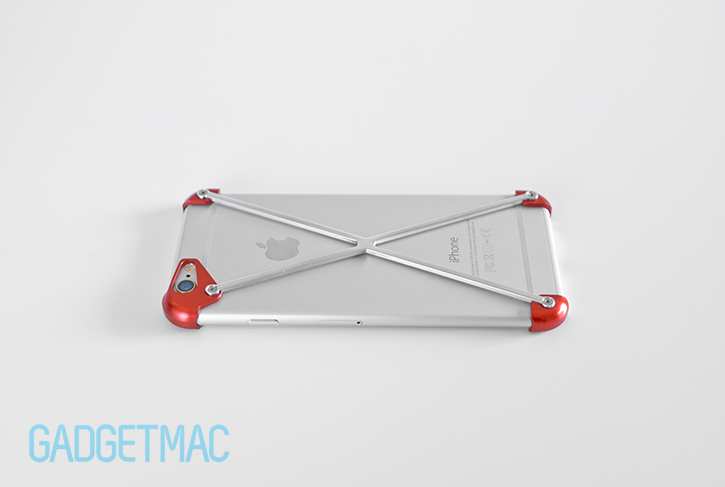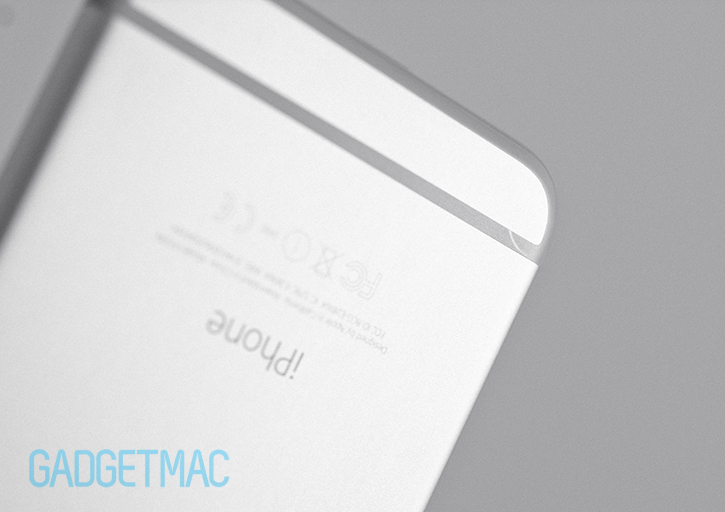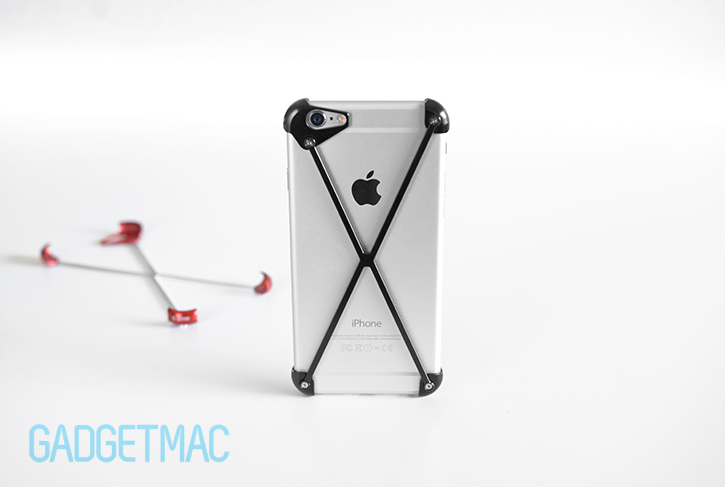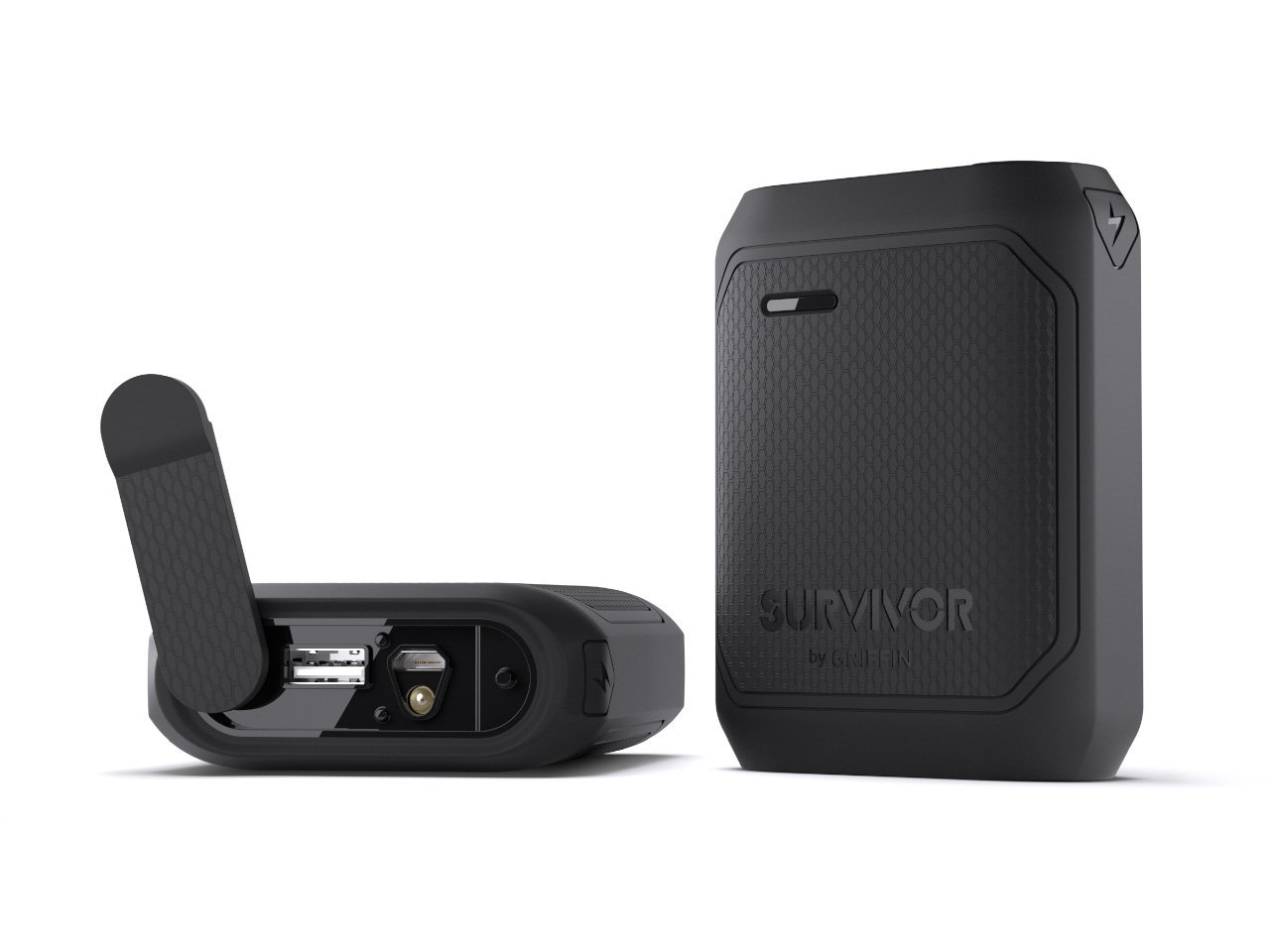Mod-3 Radius iPhone 6 & 6 Plus Aluminum Case Review
/It's that time of the year where we get the opportunity to review and show you guys one of the most unique cases for the iPhone 6 and iPhone 6 Plus...in the world. The Radius by Mod-3 has been around since the introduction of the iPhone 5, and it is now again without a doubt the strangest, most interestingly designed iPhone 6 case you can get your hands on right now. That's because it's not really a case per say, but rather an exoskeleton frame that when installed, protects all four corners of the iPhone, including protecting its front glass and the back from damage much like an ordinary case. Talk about a unique concept for an aluminum iPhone 6 and 6 Plus case. If you're looking for something different than what everyone is currently using to protect your iPhone 6 or 6 Plus, you should take a look at our full and in-depth review after the break!
For those of you seeking minimal protection for your newly acquired iPhone 6 or iPhone 6 Plus, there's a new kind of case on the market that is sure to spark your interest with its ultra-sleek and minimalist approach towards encasing the iPhone 6 and 6 Plus with the most amount of respect. We're talking about the Radius by Mod-3. It really can't be described as a case because, well, it really isn't one. It lacks the fundamental structure of a normal, conventional protective smartphone case in every sense of the word. The Radius accentuates the native design of both the iPhone 6 and iPhone 6 Plus better than most cases can, and all without compromising much of the core protection that a lot of people are seeking when looking for a protective accessory such as a case. It's every iPhone user's dream to both protect and still get to feel part of what makes using an iPhone such an awesome experience, and we think that Mod-3 has almost cracked the code with the Radius.
The Radius is radically different from what we're used to reviewing, and that's a good thing. Notably because it's a very special looking accessory from any angle. With its v-string-esque design, the Radius utilizes a four-point protective exoskeleton construction made out of lightweight machined aluminum to provide a smart and unobtrusive protective coverage around the iPhone 6 or iPhone 6 Plus to keep its most vulnerable areas safely shielded just like any other case, except it also leaves the majority of the iPhone visually and physically exposed for you to better appreciate and be able to touch whilst having a protective layer installed.
The Radius features a svelte and stylish 'X' shaped protective rear frame for the iPhone that is not only part of the Radius' distinctively beautiful design, but also effectively splits into the four corner modules that grab and secure the frame onto the device whilst making sure not to cover up the Apple logo and iPhone branding. This easily puts Mod-3's Radius at the top of the list when it comes to attractively unique accessories for the iPhone, or any smartphone for that matter. However, the Radius is currently only available for Apple's latest and older iPhone models.
It all sounds hard to believe, but there's a simple explanation as to how exactly the Radius is capable of providing decent front, back, side, top, bottom and corner protection without fully encasing the device with bulky layers of material that would otherwise cover up the beautiful design of the iPhone 6 and 6 Plus including hindering you from touching it's amazingly slim aluminum unibody and curved glass qualities. The Radius protects the iPhone by creating a raised perimeter around the device that raises it above ground. So when you lay it on its back, sides, bottom top and even face down on a relatively smooth flat surface, the Radius is the only object that actually touches that surface keeping the aluminum unibody construction as well as the touchscreen safely protected. Not of course there's still plenty of exposed areas that much like Apple's Silicone Case and Leather Case accessories for the iPhone 6 and 6 Plus, will not keep your device protected in the event you bang the side of your iPhone on the edge of a table or a curb. There's a limit to the amount of protection being offered by the Radius and it should be considered if you're, and with respect of course...a clutz.
When you're using your iPhone there's practically no grip coming from the Radius since you're essentially holding onto the naked body of the iPhone 6 or 6 Plus mostly. And that would technically seem like a downside, but in fact the Radius does pull through in giving you a more secure finger placement with its raised corner modules that in a way help prevent slippage as parts of the case grab onto your hand better than the sleek rounded body of the new iPhones. So yes, the Radius actually does provide enhanced usability, but it's still in no way a worthy competitor against the Silicone Case from Apple. Then again you are getting the best of both worlds. It doesn't look or really feel much like you're using a case with the Radius installed, and really that's the whole point behind this concept. Again, the Radius is like an elegant v-string for your iPhone 6 and 6 Plus. It's there doing its thing without you noticing it much. Only that it's in the shape of an 'X'.
On one side you get to hold onto your iPhone 6 or 6 Plus without much of the actual case obscuring the native design from reaching your grasp, while on the other you do get a more secure hold on your device whilst it is encased in this protective frame. It also weighs close to nothing as far as premium cases are concerned at just 0.26oz. Which means that you won't notice any added heft when you hold your iPhone 6 or 6 Plus with the Radius installed, and that's greatly valued to say the least. As much as we like the ultra-thin design, we fear that to a lot of people the Radius will pose an uncomfortable grip with all of its industrial metal screws around the back. More on the in a short while.
From the front, the iPhone 6 is partially augmented by the four extremely minimalist corner protection of the Radius. It especially looks attractive and eye-catching when you have a difference in color contrast between the Radius and the iPhone. But you can also keeps things more muted by color-matching the Radius with your silver, Space Gray or gold iPhone 6 or 6 Plus for a more complementary look. We do appreciate the fact that Mod-3 has kept things pure and in touch with the new design language of the iPhone 6 by not incorporating any chamfered edges around the edges of the corner modules in order to keep the Radius looking less gaudy and more seamless with the device it is encasing.
The lip that the Radius creates for the front of the iPhone to keep the glass display from contacting a flat surface such as a table is very shallow. In fact, it's even more minimal than the Apple's Silicone Case which does concern me a little in terms of effectively protecting the iPhone's glass panel from damage. Because all it would take to crack the glass upon impact is a very small piece of gravel on a sidewalk or pavement. So with that in mind, you should be aware that the Radius is not as protective as other very slim cases like Apple's Silicone Case or Leather Case when it comes to 360 degrees of coverage. In perfect drop conditioned, the Radius is likely to do its job in keeping the iPhone 6 from cracking upon impact. But whether the same will apply for the much larger and heavier iPhone 6 Plus is highly questionable. Then again, the Radius isn't designed to be a tough and durable protective case.
You can use virtually any screen protector with the Radius installed - including tempered glass screen protectors, and that's always a very welcome option to have when you're encasing your device with one form of protection. Some people prefer to be safe than sorry and we're fine with that.
The Radius is for the most part a very enjoyable case to use with the iPhone 6 because of its freeing design, but when it comes to the smaller details you start paying attention to the things that start to bother you after the first day using the it with your device. While I could hardly tell that my iPhone 6 was in my pocket, I did experience a bit of snagging when pulling out my iPhone with the Radius compared to other regular cases because of the pointy corners that were seemingly left unfinished. Although it's nothing that would make me not want to keep using the Radius. It's the front-facing corners of the corner modules of the Radius that aren't refined with a rounded edge finish that causes them to snag more on things like micro claws. You can even feel these sharp and unforgiving machined corners when you hold your iPhone at times. The fact that these corners were not carefully considered and finished to a rounded perfection is one of my least favorite things about the Radius. The case feels industrial as it is, but with this lack of attention to detail by Mod-3, it really makes the Radius less user friendly and practical than it could have been if only it had its sharp metal edges sensibly refined where the user's hand comes into contact.
Taking a look at the back corners you can see that the screw connection points for the X frame are raised above the corner modules, which is again something you can feel lightly digging into your palm when you're using your iPhone inside this case. The raised metal edges around the screws are quite sharp as well and were sadly not smoothened for your enjoyment. You eventually do get used to it after a few days of use though. But that may just be my personal experience, and of course it will vary from user to user. Ideally I would have liked to see these sections flush with the corner modules, which will greatly improve the comfort usability. The least Mod-3 can do is pay a little more attention to detail by giving these edges a round finish instead of leaving them this sharp and feeling unpleasant. And in general these corner modules don't have any smooth edges around the sides excluding the obvious roundness in their design, which thankfully also extends around the front side of these modules where they ultimately curve around the iPhone 6's aluminum bezel.
My only complaint about this X frame construction is that it sits a little too high above the back surface of the iPhone, meaning the frame could be much lower towards the aluminum instead of creating this unnecessarily high profile around the back of the device where you can notice the gap between the case and the iPhone when you hold it. It isn't a drawback by all means, it's just me nitpicking. And I'm sure others will agree as well once they get their hands on one.
The Radius being entirely made out of aluminum surely has to mean that it'll impact wireless reception. And you're right, because it does. However, due to its minimal coverage, the Radius barely degrades signal reception and does not impact 4G LTE or WiFi performance as far as we're concerned. Our 4G LTE data speed results shown above weren't affected by the Radius in real world usage scenarios. That said, you may still experience a drop in a single bar of reception. After all, we are talking about partially covering the iPhone 6's antenna band design with solid metal. Something that Apple obviously doesn't approve of. Though it's nothing new if you've ever used previous iPhone models, which have all had plenty of aluminum-made cases and bumpers made for them.
The camera opening around the back is very tight around the LED flash, but I did not experience any issues in using it whatsoever. While the Radius does cover the protruding rear-facing camera, it does introduce its own slight wobble effect and it's even worse as it can be experience from top to bottom, most likely due to the frame not being entirely flat or some parts that aren't perfectly even throughout the back. It's nothing that you will be able to make out just by looking at it nor will you be able to tell the imperfection during normal hand holding use of the Radius. It is worth noting nonetheless.
Because there's nothing that stands between you and the sides of your iPhone, pressing the buttons and activating the mute/vibrate switch on the sides is just like using your iPhone without a case at all.
The bottom area is similarly designed with a generously wide opening that invites unhindered access to the iPhone's Lightning connector and 3.5mm audio ports. Practically any headphone, 3.5mm auxiliary and Lightning connector will fit. Even every one of Apple's Lightning connector adapters. And that's something you can't say about many cases.
Mod-3 Radius in all polished silver (very reflective chrome-like finish), red & polished silver, and all slate (black).
You can grab the Radius in upwards of 7 different colors as of this review: polished silver, red & polished silver, red & slate (black), cyan & polished silver, cyan & slate (black), slate (black), and gold. All 6 colors will set you back $80 or $90 if you have an iPhone 6 Plus, with the exception of the all-gold colored Radius - which oddly enough will cost you more at $90 or a whopping $100 if you have an iPhone 6 Plus. Come on now, Mod-3. Really? Then again it was designed and is manufactured in the USA. Note that the gold Radius isn't really made with gold-plated aluminum just so that we're clear on the matter. Speaking of colors, each Radius case featured a glossy polished finished aluminum parts that Mod-3 says are all hand-polished to perfection. Not that there's anything wrong with a polished or shiny look, but we would have really loved to see a matte sandblasted aluminum finished Radius that would better compliment the native satin finish of the iPhone 6 itself. That being said, the polished finish does make the Radius pop more against the dull surface of the iPhone 6, which I think isn't half bad.
There's even a titanium version of the aluminum Radius case called the Radius Ti that sells for the low low price of $240 - $250. The difference being that it features a gunmetal-like hue of uncoated, natural titanium topped off with a brushed metal finish. Titanium is a more expensive, stronger and lightweight metal than aluminum so the price difference is somewhat understandable. If only Apple used it to construct the iPhone 6 Plus we probably wouldn't have heard about #BendGate today. All joking aside though, the Radius Ti would have been my preferred choice had it not been this expensive. It's also worth mentioning that the Radius Ti comes with a lifetime warranty as well as having a unique serial number engraved on the exterior surface of the frame.
Although not really a case, we'll still refer to it as such for all intents and purposes. Mod-3's Radius case comes inside a plain-looking white cardboard box that easily opens up like a book revealing a set of instructions required to correctly assemble the Radius onto your iPhone 6 or iPhone 6 Plus.
The case itself is protected underneath a removable layer of cardboard that flips open on either side. There's a small Allen wrench tool and an extra stainless steel screw included with each Radius case, a familiar sight for anyone that has once purchased an Element Case aluminum bumper style case.
The installation process is straightforward and not time consuming as far as machined aluminum cases that require the use of screwing a few screws here and there are concerned. While the Radius uses a total of four screws that attach the four removable corner modules (the red colored pieces in this particular example above) to the X-shaped back frame, you only need to remove the two top screws along with the two corner modules in order to install or remove the Radius. It's crucial that you do not over-tighten these screws during the installation as it is unfortunately highly likely that this case will damage the finish of your iPhone 6 or 6 Plus.
It's worth noting that these screws are the smallest we've unscrewed yet. So be careful not to drop them because you will eventually lose one, which is why an extra screw is thankfully included. Of course this means that the Radius isn't the type of case you can simply remove on the spot without it requiring you to carry around a small hex tool with you just in case. Then again, this is what makes it such a uniquely different experience from other ordinary accessories. The mere sight of these stainless steel hex screws gives the case that industrial and mechanical styling you just don't get to see when you're using a TPU or a hard plastic case. Metal case junkies will agree when I say there's no substitute other than holding an iPhone in the flesh.
The screws are fortunately very shallow and do not screw in past the aluminum layer of the corner modules as far as we can see. Mod-3 has also made sure to apply a very thin layer over the area on the inside of the case where the aluminum would otherwise touch the back of the iPhone to help prevent any potential damage from a drop or simply from tension. Alas, we ended up finding that it's not enough.
The interior side walls of every corner module is well padded with what Mod-3 call an aerospace-grade polymer material lining. It's basically a clear layer of TPU-esque material that should help absorb shock from corner impacts, although it's a very thin layer so we doubt it'll do much in the way of protection. But as you can see, only small parts of the interior are covered with this material leaving a lot of aluminum exposed.
It's also worth mentioning that the interior side of the X frame is left bare and without any protective lining. Granted it is raised above the back of the iPhone, but applying pressure on the centre does cause the frame to flex and tough the aluminum of the iPhone.
The most awful design flaw that the Radius has due to lack of proper lining of the aluminum parts that cover the four corners of the iPhone 6 and 6 Plus is that with some force, these aluminum parts leave a permanent outlined impression in the plastic antenna lines. I've experience this when I removed the Radius after a week of use. It's a subtle but noticeable marring of the plastic finish due to the pressure that was applied by the fitting of the bare aluminum edges of the Radius's corner bumpers. You do need to see this at an angle and with just the right light reflective off of the plastic surface to see the unfortunate and permanent cosmetic damage caused by the usage of this case and its lack of interior lining coverage. There's no telling how badly the lack of proper interior padding on the Radius will affect the finish of both the aluminum and plastic antenna lines of the iPhone in the unfortunate event of a drop and impactful force applied on these corner modules. The Radius has cosmetically ruined all four corners of our iPhone 6 model we use for testing purposes even though we have followed the directions in not over-tightening the screws nor did we ever drop the device, and we're not happy about that. Over the years we have reviewed countless cases with parts that were made out of metal, the the Radius is the first one that has cosmetically marred our device. It's a small blemish, but a blemish nonetheless.
If you simply cannot live with a case that inhibits the ability to swipe your thumb across and over the iPhone's majestic beveled glass edges, then the Radius might be something worth checking out. But before you do, there's some caveats to bare in mind. As much as we like the Radius and its unique approach to protection, it most definitely isn't for everyone. It's for those who want to appreciate the brilliant aluminum, rounded glass design and super sleek form factor of their iPhone 6 and iPhone 6 Plus without covering it up with a traditional case. The Radius allows you to enjoy the premium materials and native design of the iPhone as much as possible whilst still protecting the most commonly damaged areas of the devices from accidental drops and scratches from normal everyday usage using an ultra-lightweight, attractive aluminum exoskeleton-esque case.
There's really no greater feeling than being able to hold your iPhone 6 or 6 Plus and feel it's bare design knowing that it is still being protected...however lightly. It takes a certain type of individual with a unique personal taste and preference to be rocking a case such as the Radius. A part of me really likes the Radius case and how great it feels in allowing you to feel more of your iPhone, but then a different part of me knows that it's far from being perfect. It most certainly isn't for everyone nor will it ever hit the mainstream of case protection, but as far as we see it it's one of the most attractively designed accessories out there for the iPhone 6. It may offer decent protection at general crucial impact points found around the iPhone, but the best thing about Mod-3's Radius is that it lets you enjoy your purchase better than most cases as Apple intended it to be.
Sadly, it's not perfect and there's plenty of room for improvement. For starters the Radius' raised screw mountings are a bit sharp leaving the corner edges of the bottom corner modules to be uncomfortably felt as they lightly dig into your palm. There's a small trace of signal degradation, but worst of all, the Radius lacks proper interior lining insulation to keep the aluminum corner modules from cosmetically damaging the finish of the plastic antenna bands around the back of the device. There's little protective lining leaving parts of the edges around the outside of the aluminum corners to ultimately leave behind an impression/mark on the plastic from normal usage without over-tightening the screws or introducing the case to impact. This flaw has got to be improved immediately. Not good enough, Mod-3.




























































